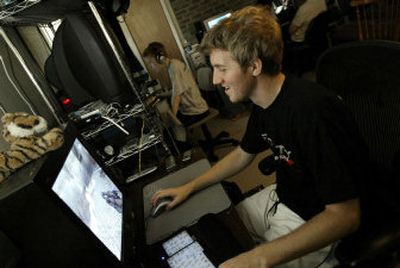High-level players can make career out of video gaming

KANSAS CITY, Mo. – Johnathan Wendel is in training. Eight hours a day, seven days a week, he sits in his basement, gunning down opponents in the video game “Painkiller.” About the only time he leaves his house is for a daily three-mile run. Then it’s back to the basement for round after bloody round of the first-person shooter, a game in which the player becomes the gunman.
Wendel, or Fatal1ty as he is known in the competitive gaming world, is a professional cybersportsman known for his skillful aim.
At the Cyberathlete Professional League’s World Tour Grand Finals, kicking off in New York today, he hopes to take the $150,000 first prize, adding to the $86,000 he’s already earned competing in live tournaments this year.
That’s in addition to the tens of thousands he’s made licensing his name – to computer motherboards, cooling systems and sound and graphics cards.
“I’m so focused on this tournament, I don’t want to go outside much. I don’t want to party. I want to stay focused and be in my world,” said Wendel, 24.
For an increasing number of top-level players, video games are no longer just for fun – they’re an “e-sport” that can make a career. Over the last few years, video gaming has grown into a highly competitive phenomenon, with live tournaments, star players, devoted fans and, just as in the traditional sports world, big salaries and egos.
Many of today’s top cyberathletes are sponsored by corporations and earn six-figure incomes competing before live audiences in tournaments around the world.
While the mainstream media may not be familiar with the term “e-sports,” it’s poised to move from hard-core gamer niche to the pop culture arena. Today, MTV kicks off a week of video-game programming, which will include live coverage of the CPL finals.
At CPL tournaments, gamers are allowed to bring their own keyboard, mouse and headphones, but the more crucial game-play variables are nullified. All the computers are identical, with the same video cards, processors and monitors.
Official tournaments date to 1997, when Dallas-based video game developer id Software ran a tournament for players of its popular game, “Quake.” The winner won a used Ferrari; everyone else got computer parts.
It was that tournament that gave Angel Munoz, a former investment banker, the idea for the CPL. Realizing video gaming could be presented as a sport, “the spark went off,” he said.
Like other pro sports, he envisioned sponsorships, licensing deals, merchandise and ticket sales.
Eight years later, they are all a reality. And not just with the CPL. Today there are multiple leagues holding tournament series all over the world, the largest being the CPL, the E-Sports World Cup and the World Cyber Games, the latter of which took place last week, drawing 7,000 fans, players from 67 countries and 300 reporters.
New tournaments are springing up all the time. They are now a standard component of nearly every gaming convention.
By some industry estimates, there are 30,000 competitive gaming teams worldwide, and that’s in addition to players who compete one-on-one. Those numbers can only increase as more homes adopt broadband Internet service, growing the online gaming scene and upping the competition for its live tournament counterpart.